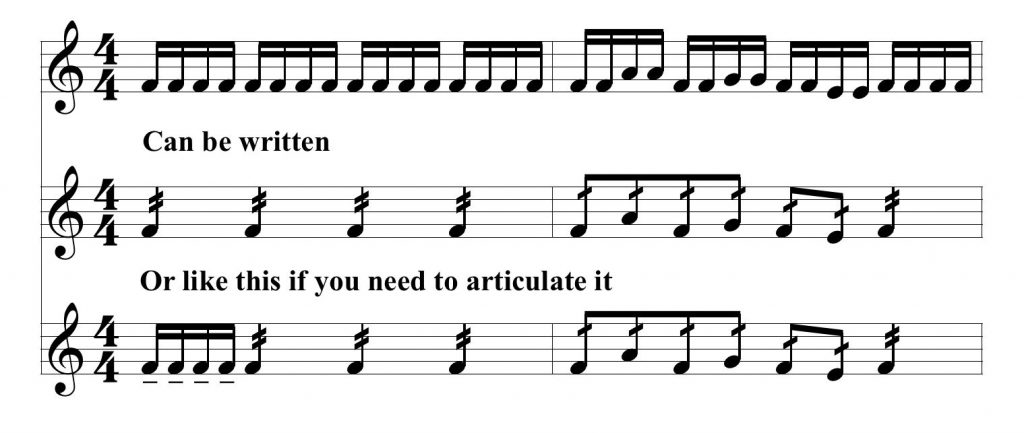| Name of String
Articulations |
Name of Wind
Articulations
Best Inst & Reason |
Name of Brass
Articulation
Best Inst & Reason |
Graphic Marking
|
| |
|
|
|
| Legato bowing |
Slurred (not tongued)
Best = All
|
Slurred (not tongued)
Best = All |

|
| Detache bowing |
Tongued: Default way to
articulate notes if no
marking is present.
Best = All |
Tongued: Default way to
articulate notes if no
marking is present.
Best = All |

|
| Staccato
bowing |
Staccato:
Shorter articulation of
note than normal.
Best = All
|
Staccato:
Shorter articulation of
note than normal.
Best = All |

|
Spiccato
Bowing
|
Spiccato.
Even Shorter than
Staccato. May be
interpreted with a slight
accent by some players.
Best = All
|
Spiccato.
Even Shorter than
Staccato. May be
interpreted with a slight
accent by some players.
Best = All |

|
Portato
|
Sometimes known as "soft tonguing", "legato tonguing" or "Portato" Best = all Winds
|
Sometimes known as "soft tonguing", "legato tonguing" or "Portato" Best = all brass. Particularly effective in the brass which naturally seperate notes more than others. |

May also appear as slurred
staccato
|
| Con Sordino |
Con Sordino
Best = Bassoon or Clarinet
w/windscreen. Solid
mutes will completely
close bore and prevent the
lowest note from sounding.
Unusual but available by
using something to cover
bell or opening of tube.
Also Subtone in Clarinet
for extremely soft dynamic
PPPP
|
Con Sordino Including
the following:
Harmon, Straight, Bucket,
Plunger, Cup, Solotone,
Best = Trumpet or Tombone.
Horns can do hand stops or
straight mutes. Tuba mute
is unweildy
|
Text Marking: "Con
Sordino"
Add mute type for
brass to text marking
Negate Marking: "Ord"
or Normale"
For Subtone in Clarinet
write "Subtone" or 4 or
more PPPPP
|
| Jete and Saltando
(spontaneous Spicc) |
Double and Triple Tongue
Best = Flute = Nothing in
the mouth. |
Double and Triple Tongue
Best = All = Nothing in
the mouth. |
Strings Text Marking:
"Jete"
Negate Marking: "Ord" or
Normale"
At times, No Marking is
necessary will be executed
upon players discretion |
| Trills |
Trills
Best = All |
Trills
Best = Trumpet for
standard trill. Available
on Horn but sardonic. Lip
trill available in upper
registers on all but less
convincing in its
undulation. |
 |
| Bowed Tremolo |
Flutter Tongue
Best = Flute = Nothing in
the mouth. |
Flutter Tongue
Best = All = Nothing in
the mouth. |
 |
| Measured Tremolo |
Timbral Trills or double
or triple tongue
Best = Flute = Nothing in
the mouth.
|
Timbral Trills or double
or triple tongue
Best = All = Nothing in
the mouth. |

|
| Fingered Tremolo |
Tremolos
Best = Clarinet = allow
most combination of
interval. Intervals
>P4 should consult
fingering chart. |
Tremolos
Best = trumpets. Very
difficult in Trombones.
Lip tremolo ("shake") at
certain intervals
available in upper
registers on all but less
convincing in its
undulation. |
 |
| Harmonics |
Harmonics
Best = Flute = natural
manner of producing first
1+1/2 octaves. Easily
executed. Note Harmonics
begin at the 3rd Partial
|
Cuivre
Best = French Horns=
Extreme overblow creates a
disturbance in the
airflow. |

|
| Bowed Glissandi |
Glissandi
Best = Clarinet = Open
holes allow player to
slide finger |
Glissandi
Best = Trombone = Natural
mechanism of the
instrument is a continuous
slide. Be mindful of the
interval restriction. |
 |
| Fingered Glissandi |
Glissandi
Note: This is not a slide
glissandi rather the
player quickly runs
through the chromatic
scale.
Best=all |
Glissandi
Note: This is not a slide
glissandi rather the
player quickly runs
through the chromatic
scale.
Best=all |
 |
| Pizzicato |
Staccato or "slap
tongue"
Best = flute or clarinet =
bigger single reed or no
reed. |
Staccato
Best = all
Also hand slap on tuba
mouthpiece is effective. |
Text Marking: "Slap
Tongue"
Text Marking: "Pizz"(strings
only)
Graphic Marking see
Staccato
Negate Marking: "Ord"
or Normale"
|
| Sul Tasto, Sul Pont |
Sub Tones, Hoots,
Whistle Tones other
extended techniques |
Not as many extended
techniques in brass. Some
include "Wah Wah" , Molto
Vibrato |
Text Marking
|
| quarter and micro tones
|
quarter and micro tones
|
half valve microtone
gliss and embochure bends. |
 |